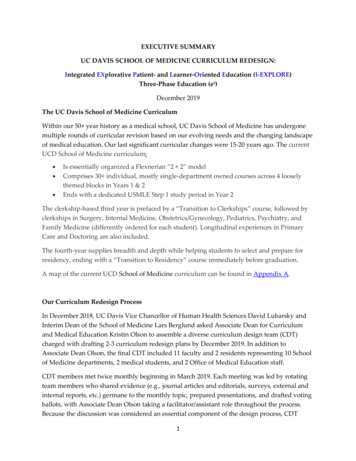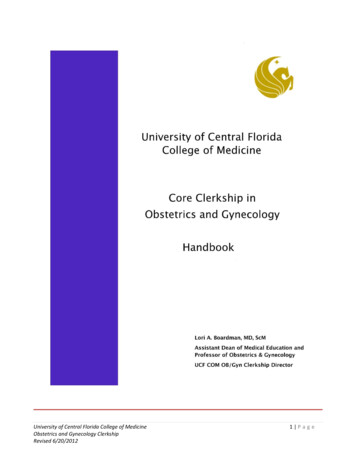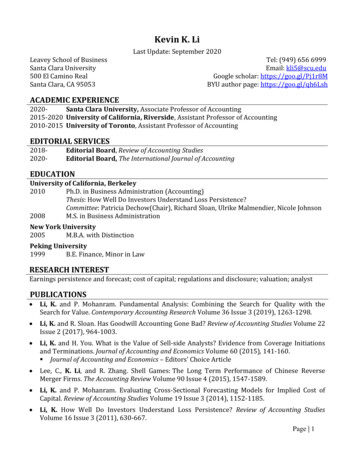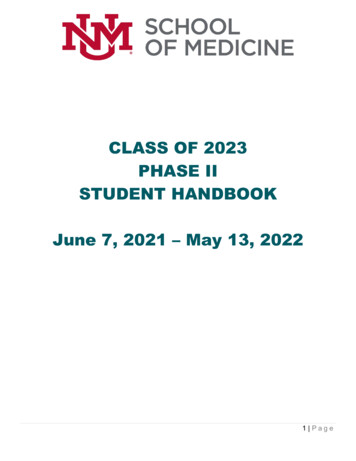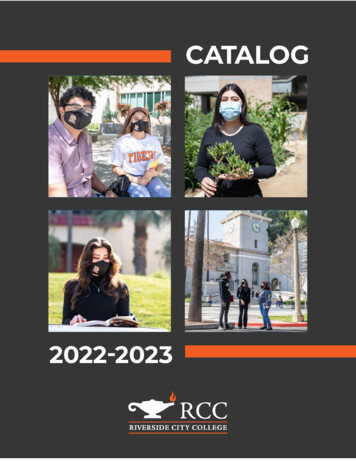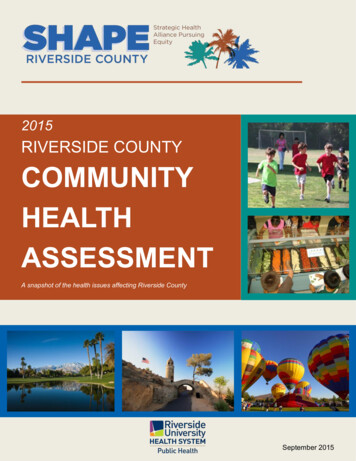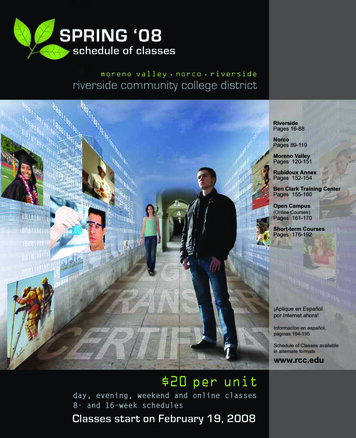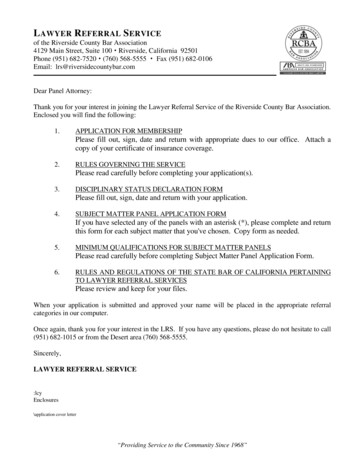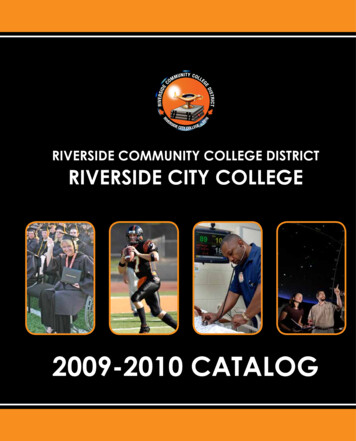
Transcription
Rev. August 2020GOALS AND OBJECTIVES OF MEDICAL STUDENT ROTATIONRUHS - DEPARTMENT OF ANESTHESIOLOGYHaving a fundamental knowledge of anesthesia prior to your rotation will greatly facilitate yourexperience here. Review the rotation curriculum to help guide your preparation.OVERALL GOALS AND OBJECTIVES OF THE ANESTHESIOLOGY ROTATION1. To develop an awareness of the breadth and depth of the practice of anesthesiology2. To participate in all aspects of anesthesiology including preoperative assessment, intraoperativecare and PACU management3. To understand the basic principles of airway management, management of surgical patientswith coexisting diseases, contraindications for anesthetic techniques and commoncomplications of anesthesia and management4. As skills advance and time allows; observe and participate in regional and neuraxial anesthesiaand other procedural aspects of anesthesiaPre-Op1. Conduct the basic pre-anesthetic patient evaluation:a. Patient co-morbidities which can affect the anesthetic planb. Medicationsc. Social Historyd. Integrate pre-op H&Ps, labs, imaging, additional studies, etc.e. NPO statusf. Airway examg. Physical Examh. Risk stratification2. Understanding of potential anesthetic options for a given surgical procedure3. Formulate an anesthetic plan for a basic surgical procedures4. Demonstrate knowledge of the objectives for effective preoperative medication administrationincluding:a. Relief of anxiety/sedation/amnesiab. Analgesiac. Drying secretionsd. Reducing gastric acidity and volume5. Demonstrate knowledge of the basic pharmacology, pharmacokinetics and contraindications ofthe following premedication agents:a. Opioids/narcoticsb. Sedatives
Rev. August 2020c. Anticholinergicsd. Drugs used to reduce the incidence or consequences of pulmonary aspiration6. Present the patient to the designated anesthesia provider (resident/sRNA/dentalanesthesia/OMFS resident/etc.) assigned to that case7. Eventually be able to present patient and cases to anesthesia attendingsMain Operating Room1. Students will most commonly be assigned to an anesthesia provider in one of the 10 mainoperating rooms2. Most anesthesia providers arrive between 6:00 and 6:15 to setup the room. Room setup is akey part to success in patient care and where you can help your resident prepare for the day. Inaddition, you will be able to show knowledge about the day’s cases and how you have preparedfor the upcoming day3. Students should arrive in pre-op holding following morning lecture to pre-op their scheduledpatient. At that point, the student can discuss the patient with his or her anesthesia providerand formulate an anesthetic plan. The student/anesthesia provider team can present to theattending physician for final approval. Generally, patients should be in the OR by 7:30am (8:30on Wednesdays)4. When in the OR, the student can assist the anesthesia provider in hooking up the patient to thepulse ox probe, BP cuff and ECG leads (in that order) and then placing on oxygen, as wells ashelping remove the stretcher from the OR room5. Students should be able to demonstrate understanding of basic patient monitoring techniquesa. Basics of pulse oximetry1. Which finger does it go on and why?b. Basics of non-invasive and invasive blood pressure monitoring1. NIBP vs. arterial BP; indications for both2. Utility of ABGs obtained from an arterial line – be able to interpret anABG and evaluate acid/base statusc. ECG placement1. Ischemia detected by Leads I, II, III2. definition and purpose of modified V5 leadd. What order are these monitors placed onto the patient in? why?6. Masking, laryngoscopy and intubation will be at the discretion of the attending and anesthesiaprovider, but students should be able to explain how to perform steps pertaining to each skill.a. Student should be able to master appropriate masking technique, jaw thrust, etc.b. Student should be knowledgeable of proper tube sizes (7.0-8.0), laryngoscopy blades(Mac vs. Miller, etc.), proper masking technique, etc.7. Students should be able to demonstrate knowledge of basic airway managementa. Discuss differences between different airway management techniquesb. Discuss basic oropharyngeal and laryngeal anatomy
Rev. August 20208.9.10.11.12.c. Laryngeal Mask Airway (LMA) vs. Endotracheal tube (ETT)1. Risks and benefits of each, contraindications, etc.d. Indication for Rapid sequence induction (RSI)1. Why do we perform this and what medications do we use?Students should be able to identify several agents used at induction of general anesthesia(advantages/disadvantages)a. IV agentsb. Inhalational agentsa. What is MAC? You MUST know this definition and the individual MACs of eachinhalational agentc. Neuromuscular blocking agentsa. What is the difference between a depolarizing neuromuscular blocking agentand a nondepolarizing neuromuscular blocking agent?d. Vasoactive medicationsStudents may have the opportunity to place IV catheters, gastric tubes, esophageal probes andother monitor on a case by case basisStudents should understand perioperative fluid and electrolyte therapy: what each solutioncontains and indications for administrationa. Demonstrate knowledgeable about how is volume status evaluated using the patientsand monitors?b. Discuss indications, risks and benefits of each type of fluid replacement therapies(including relation to blood volume/volume losses, oxygen carrying capacity, trauma,coronary artery disease, etc.)1. Crystalloids: Normal saline vs. lactated ringersa. Which electrolytes do each contain?b. Are they isotonic/hypotonic/hypertonic solutions?c. Be able to formulate a chart for fluid replacement strategies(Deficit, maintenance, intraop/EBL losses, insensible losses)d. How long do these solutions stay intravascularly? Describe theconcept of “third spacing”.2. Colloids: Albumin vs. starchesa. Advantages and disadvantages of both3. Blood products: pBRCs, FFP, platelets, etc.a. How are these products administered? What solutions are theyadministered with? Are they warm? Cold?Students should be able to identify several position-related injuries that patients may sustainduring general anesthesiaStudents should be able to discuss methods of recognizing and treating various preoperativeproblemsa. HTN, hypotension, Low O2sat, hyper/hypocarbia, endobronchial intubation, esophagealintubation, dysrrhythmias, pulmonary embolism, etc.
Rev. August 202013.14.15.16.b. Student should be able to understand basic ventilator settings and how they affect thepatienti. Volume control, pressure control, SIMV (synchronized intermittent mandatoryventilation), PSVPro (pressure support mode)Students may assist in documentation as delegated by the anesthesia provider in the roomRemember that during the case there is valuable time to learn from the anesthesia providers,but try to time your questions and discussion appropriately, as patient care always comes first.The residents will do their absolute best to teach and assist you in developing your fund ofknowledge and skill base as the case allows.If there is a case pending, the anesthesia provider will likely dismiss you from the OR to go preop the next patient. Remember to be thorough, but efficient with your time. When you aredone, report back to your anesthesia provider with your findings and discuss the plan for thenext caseUpon emergence and extubation of the patient, the anesthesia provider will be in charge of theairway and you can help assist by gathering paperwork, bringing the bed into the OR at the endof the case, as disconnecting the monitors when the resident deems appropriateObstetrics1. Develop a basic knowledge in regional and general anesthesia as it relates to the pregnantpatient and better understand the pharmacology and physiology involved.2. Collaborate with their assigned anesthesia provider to complete preoperative H&Ps and to assistin formulating an anesthetic plan3. Obstetric anesthesia is markedly different than anesthesia provided in the main operating roomand students should have read and demonstrate an understanding of maternal/fetal physiologyand anesthesia for obstetrics before their obstetric day.PACU/Regional1. Students may have an opportunity to follow the senior resident assigned to PACU/Regional (PR)and become familiarity with PACU care of post-op patients and regional anesthesia. On thesedays students may also assist with resident-performed blocks.2. Students should be able to demonstrate knowledge of local anesthetic pharmacologyappropriate to the practice of anesthesiaa. Classifying commonly used agents according to amide or ester linkageb. Listing commonly used local anesthetics for: topical use, local infiltration, peripheralnerve blocks, spinal and epidural usei. Including pharmacodynamics of each agentc. Describing and identifying signs of impending local anesthetic toxicity (particularly thedifference between bupivacaine and other local anesthetics)d. Discussing the specifics of allergic reactions to local anesthetics3. Students should be able to demonstrate knowledge of spinal and epidural regional anesthesia
Rev. August 2020a. Describe the indications for spinal and epidural anesthesiai. What can we use for c-sections? For pain control for laboring patients?b. Describe the motor/sensory/autonomic effects of spinal and epidural anesthesiac. Describe the hemodynamic effects of spinal and epidural anesthesia4. Students should be able to demonstrate knowledge of the different types of pain management,including:a. Peripheral nerve blocksi. Ultrasound vs. peripheral nerve stimulation identification of structuresb. Pain management medicationsi. Toradol, acetaminophen, caldolor, narcotics and timing of dosage of thesemedicationsc. Identification of post-op complications and treatmenti. Airway obstruction, respiratory depression, hypoxia, pulmonary edema,inadequate reversal from neuromuscular blocking agents, nausea/vomiting,shivering, malignant hyperthermia, etcWEEKENDS/HOLIDAYS1. Students should utilize weekends for down time and studying anesthesia related material.Please don’t feel obligated to come in on a weekend or night shift. We would much rather youcome to main OR time knowledgeable, refreshed, confident, and ready to learn.MORNING LECTURES1. The lecture schedule is posted on the resident schedule board outside the Medical StudentRotation Coordinator office. It behooves you to read in advance about the lecture topic, as ithelps you follow along in lecture.IMPORTANT DON’TS1. Students are NEVER to prepare or administer medications, including volatile gases.2. It is unacceptable to be late for morning lecture.3. Do NOT sign any forms that are to be placed in the patient’s chart.GOOD LUCK AND ENJOY YOUR ROTATION!!
anesthesia/OMFS resident/etc.) assigned to that case 7. Eventually be able to present patient and cases to anesthesia attendings. Main Operating Room . 1. Students will most commonly be assigned to an anesthesia provider in one of the 10 main operating rooms 2. Most anesthesia providers arrive between 6:00 and 6:15 to setup the room. Room setup .
